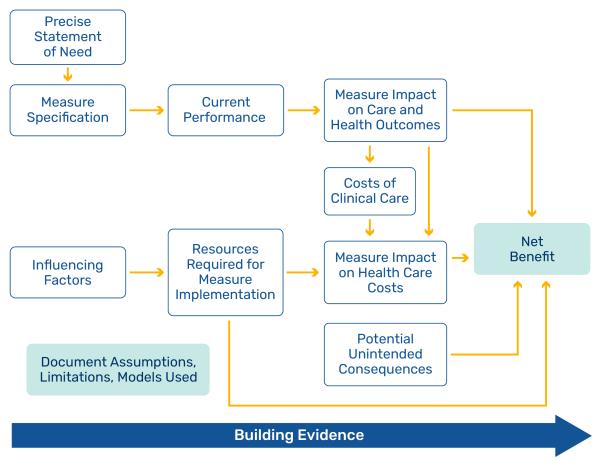Business Case Best Practices
Six Elements of a Well-Constructed Business Case
| Net Benefit | A summary of all of the potential advantages and disadvantages associated with the implementation of this measure. Essentially serves as an executive summary for the rest of the business case. |
| Statement of Need | Justification for why this measure is necessary--a description of the measurement or performance gap this measure will address. |
| Measure Impact | Detailed description of how the implementation of this measure will affect the health care system--including impacts to care delivery, patient experience (e.g., wait times, additional paperwork), potential unintended consequences, and potential to game the system. |
| Influencing Factors | What external factors are likely to impact the measure's performance? |
| Resources Required | Description of what it would take to implement the measure in the care setting (e.g., workflow changes, new technology, new data fields in the electronic health record, staff training, and interoperability). |
| Costs of Clinical Care | Taking into consideration the other five elements, how will this measure impact the costs of care? Will it increase efficiencies and reduce waste, thereby reducing the overall cost of care? Or will it promote the use of more expensive equipment or testing, thereby increasing the cost of care while improving care quality? |
The figure describes the flow of building evidence for a business case and determining the net benefit of the measure. Click the image to enlarge.
It is imperative for measure developers to pinpoint a precise statement of need to justify the requirement of the measure. The measure developer may identify the need by analyzing the performance or measurement gaps discovered during the environmental scan.
Measure developers should also document influencing factors (e.g., policies and practices) that may impact the measure’s performance. Measure developers may identify influencing factors in the environmental scan. Resources required for measure implementation (e.g., financial, technological, workforce-related) should also be inventoried drawing from the environmental scan, feasibility testing, and Technical Expert Panel input as they directly affect the measure’s net benefit.
Measure developers should assess measure impact (e.g., health and health care outcomes, health care costs) quantitatively using validated instruments and metrics, and clearly link those expected benefits assigned to a model for testing. The measure developer should also assess the measure’s effect on the cost of clinical care, which may mediate the link between impacts on health and health care outcomes and impacts on health care costs. Using the example of increased physician follow-up visits, improved care coordination may not only reduce expenses associated with unnecessary readmissions, but could also reduce mortality in selected populations and improve patient experience (e.g., Consumer Assessment of Healthcare Providers and Systems).
Regardless of the model used, the business case should include an explicitly stated hypothesis for use in later testing and, at a minimum, predict how the measure will have an effect over time (the trajectory). This enables the measure developer to make comparisons during measure use, continuing evaluation, and maintenance. When possible, the measure developer should include historical and baseline data—that is, data collected from the measure (if completing for maintenance) or similar measures (identified during the environmental scan).
Using the business case to evaluate measure performance
After implementation of the measure, the measure developer should compare the business case and predictions about measure performance, which helped inform decision-making during measure development and selection for use, against actual performance. If hypothesized improvements in health, measured entity care performance, and cost savings occur as predicted, then the measure is succeeding in terms of the business case. If hypothesized improvements are absent, are less/fewer than anticipated, or there are unintended consequences observed, then the measure developer should reexamine the data, reevaluate the justification for the measure, and analyze why improvements are not occurring. The measure developer then should adjust the business case for any changes in the health care environment and revisit the initial assumptions as needed. For annual updates of measures in use and for continuing evaluation, simply reporting measure performance relative to predictions may be sufficient. For the comprehensive reevaluation, the measure developer should conduct a full analysis, and then report recommendations for improvement in an updated business case.

